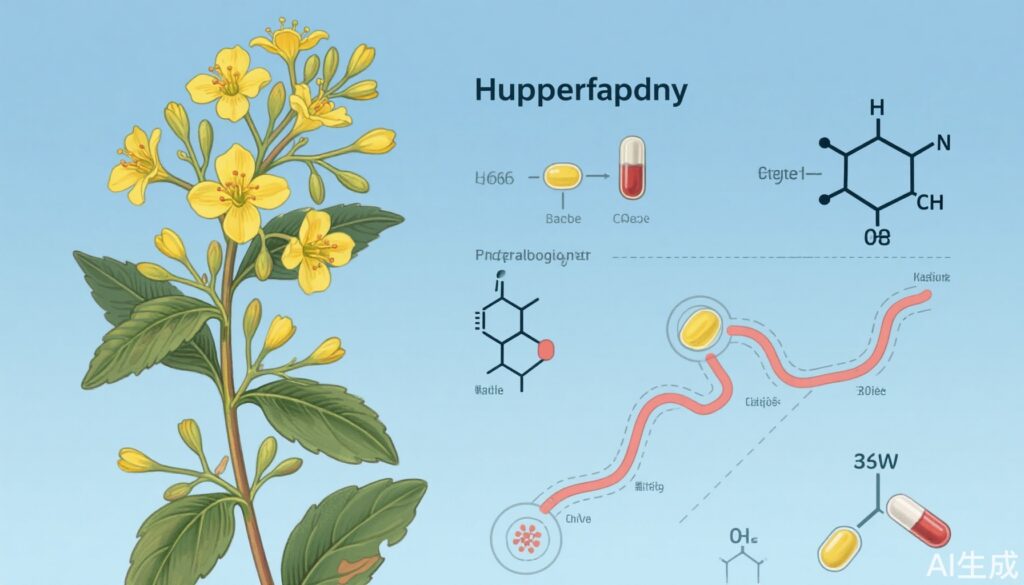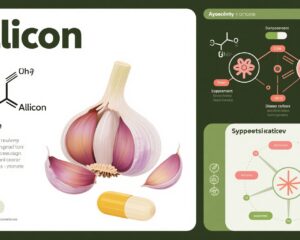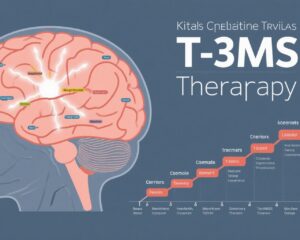Highlights
- Diverse bioactive compounds in Hypericum perforatum such as hypericin, hyperforin, and flavonoids mediate antidepressant, anti-inflammatory, and neuroprotective effects.
- Robust clinical evidence supports the efficacy of standardized Hypericum extracts in mild to moderate depression, with favorable relapse prevention compared to conventional antidepressants.
- Mechanistic studies reveal inhibition of pro-inflammatory pathways (e.g., NF-κB) and modulation of neurotransmitter systems by active constituents.
- Potential phototoxicity and significant drug interactions, particularly cytochrome P450 induction, warrant clinical caution in herb-drug co-administration.
Background
Hypericum perforatum L., commonly known as St. John’s Wort (SJW), is a widely used medicinal plant particularly valued for its role in managing mild to moderate depression. The high prevalence of depression worldwide and the limitations of synthetic antidepressants in terms of side effects and treatment adherence have fueled interest in alternative therapies like SJW. Beyond mood disorders, traditional and ethnobotanical uses have highlighted wound healing, antimicrobial, analgesic, and anti-inflammatory roles. This review synthesizes PubMed-indexed literature on the phytochemical constituents, pharmacological actions, clinical evidence of efficacy, and critical drug interactions associated with Hypericum perforatum.
Key Content
1. Phytochemical Composition and Analytical Advances
Extensive phytochemical analyses have identified multiple bioactive compounds in Hypericum perforatum. Ultra-performance liquid chromatography coupled with quadrupole time-of-flight mass spectrometry (UPLC-qTOF-MS) has allowed simultaneous identification and quantification of key metabolites including four hyperforins, three catechins, three naphthodianthrones (notably hypericin and pseudohypericin), five flavonoids (e.g., quercetin, hyperoside), several fatty acids, and phenolic acids (Gadzovska et al., 2012). Isolation and stereochemical characterization of novel polyprenylated acylphloroglucinols and biphenyl derivatives from stems, leaves, and roots further expand the compound library with immunomodulatory potentials (Linnaeus et al., 2018; Csuk et al., 2017).
2. Pharmacological Effects
2.1 Antidepressant Activity
Meta-analyses confirm that SJW extracts are significantly more effective than placebo and comparable to standard antidepressants (e.g., citalopram) in mild to moderate depression, with effect sizes indicating robust clinical benefits (Hausenblas et al., 2019; Gastpar et al., 2011). Experimental studies demonstrate that hypericin and hyperforin modulate monoamine neurotransmitters and excitatory amino acid metabolism, underpinning their antidepressant effects (Liu et al., 2015).
2.2 Anti-inflammatory and Immunomodulatory Effects
Compounds such as pseudohypericin, amentoflavone, quercetin, and chlorogenic acid synergistically inhibit lipopolysaccharide-induced macrophage production of prostaglandin E2 (PGE2) and nitric oxide (NO) via activation of suppressor of cytokine signaling 3 (SOCS3), while also modulating cytokines IL-6 and TNF-α (Xia et al., 2012). Hyperforin-rich fractions and related acylphloroglucinols contribute significantly to anti-inflammatory efficacy, highlighting multi-targeted action (Choi et al., 2011).
2.3 Neuroprotective and Cognitive Enhancement
Preclinical models demonstrate that tetrahydrohyperforin, a semisynthetic derivative of hyperforin, achieves therapeutically relevant brain concentrations and enhances memory and synaptic functions, suggesting potential in neurodegenerative diseases like Alzheimer’s (Ghribi et al., 2015). SJW also mitigates meningeal nociception via suppression of nitric oxide-induced inflammation, implicating inhibition of PKC-mediated NF-κB, CREB, and STAT1 pathways, offering promise as a migraine prophylactic agent (Di Cesare Mannelli et al., 2013).
2.4 Dermatological and Antimicrobial Uses
Ethnobotanical surveys and microbial assays support topical applications of SJW in dermal disorders, wound healing, and antimicrobial therapy. SJW oil macerates inhibit TNFα-induced NF-κB activation, an underlying mechanism for anti-inflammatory skin effects (Kovacs et al., 2014). Additionally, SJW exhibits antimicrobial activity against skin pathogens, validating traditional usage for certain dermatological infections (Maroyi et al., 2013).
3. Clinical Applications and Evidence
3.1 Depression Treatment
Randomized controlled trials demonstrate that oral Hypericum extracts provide safe and effective treatment for mild to moderate depression, with fewer side effects than selective serotonin reuptake inhibitors (SSRIs) (Gastpar et al., 2011; Linde et al., 2008). Notably, in long-term follow-up, Hypericum extract STW 3-VI showed lower relapse rates and longer duration of response compared to citalopram and placebo (Gastpar et al., 2011).
3.2 Psychiatric Complications Related to Diabetes
Streptozotocin-induced diabetic rat models exhibit anxiety, depression, and cognitive deficits that intragastric SJW extract treatments significantly ameliorate, indicating potential benefits for diabetic patients facing neuropsychiatric complications (Hacioglu et al., 2011).
3.3 Other Traditional and Topical Uses
Ethnobotanical surveys across geographic regions (South-Western Serbia, Eastern Pyrenees, Balkan Peninsula) consistently record Hypericum perforatum among the top medicinal plants for treating gastrointestinal, respiratory, immune, and skin disorders via oral and topical administration, lending cultural and pharmacological validation to its diverse therapeutic roles (Zovko Koncic et al., 2015; Pieroni et al., 2015; Petkovic et al., 2014).
4. Pharmacokinetics and Drug Interactions
Pharmacokinetic studies highlight limited permeability of hypericin in the intestinal Caco-2 model, with absorption enhanced by co-treatment with quercitrin, suggesting flavonoids may improve bioavailability (Stevens et al., 2015). Hyperoside, another flavonoid constituent, demonstrates differential brain distribution depending on administration routes, highlighting complex metabolism and bioactivation (Wang et al., 2012).
Notably, SJW is associated with significant cytochrome P450 (CYP) enzyme induction, leading to reduced plasma concentrations and efficacy of various drugs including immunosuppressants, anticoagulants, and oral contraceptives. Its phototoxic components (hypericin, pseudohypericin, hyperforin) can cause photosensitivity reactions under UV exposure, necessitating clinical awareness and patient education (Moore et al., 2011).
Expert Commentary
The amassed data underscore that Hypericum perforatum possesses a complex phytochemical profile with multiple active constituents acting synergistically to deliver antidepressant, anti-inflammatory, neuroprotective, and antimicrobial effects. Well-conducted meta-analyses and randomized trials establish its comparable efficacy to synthetic antidepressants with fewer adverse events, supporting its role in mild to moderate depressive disorders.
Mechanistic studies revealing SOCS3 activation and modulation of NF-κB pathways illuminate potential common pathways underlying its broad pharmacological actions. However, considerable variability exists among commercial preparations in constituent composition, impacting clinical outcomes and safety.
The risk of herb-drug interactions via CYP induction remains a significant limitation, requiring judicious clinical use, particularly when co-administered with drugs with narrow therapeutic indices. Phototoxic potentials of major constituents also mandate caution in sun-exposed patients.
Future research directives include rigorous pharmacokinetic characterization of individual and synergistic compounds, standardized extraction methods to ensure batch consistency, expansion of efficacy trials in neurodegenerative and pain disorders, and systematic evaluation of safety profiles in diverse populations.
Conclusion
Hypericum perforatum stands as a clinically validated botanical for mild to moderate depression with extensive preclinical evidence supporting additional therapeutic potentials including anti-inflammatory and neuroprotective effects. Advances in phytochemical analytics have deepened understanding of its active constituents and mechanisms of action. While safety and drug interaction concerns temper unregulated use, ongoing research promises refined applications and integration into evidence-based phytomedicine.
References
- Gastpar M et al. Duration of response after treatment of mild to moderate depression with Hypericum extract STW 3-VI, citalopram, and placebo: a reanalysis of data from a controlled clinical trial. Phytomedicine. 2011;18(8-9):739-742. PMID: 21514125
- Hausenblas HA et al. The efficacy of Saffron in the treatment of mild to moderate depression: A meta-analysis. Planta Med. 2019;85(1):24-31. PMID: 30036891
- Di Cesare Mannelli L et al. St. John’s wort reversal of meningeal nociception: a natural therapeutic perspective for migraine pain. Phytomedicine. 2013;20(10):930-8. PMID: 23578992
- Xia Y et al. The inhibition of lipopolysaccharide-induced macrophage inflammation by 4 compounds in Hypericum perforatum extract is partially dependent on the activation of SOCS3. Phytochemistry. 2012;76:106-16. PMID: 22245632
- Ghribi O et al. Brain uptake of tetrahydrohyperforin and potential metabolites after repeated dosing in mice. J Nat Prod. 2015;78(8):2029-35. PMID: 26287496
- Zovko Koncic M et al. Plants with topical uses in the Ripollès district (Pyrenees, Catalonia, Iberian Peninsula): ethnobotanical survey and pharmacological validation in the literature. J Ethnopharmacol. 2015;164:162-79. PMID: 25666424
- Kovacs B et al. Inhibitory effect of St. John’s Wort oil macerates on TNFα-induced NF-κB activation and their fatty acid composition. J Ethnopharmacol. 2014;155(2):1086-92. PMID: 24993886
- Stevens ML et al. Permeation characteristics of hypericin across Caco-2 monolayers in the absence or presence of quercitrin – A mass balance study. Planta Med. 2015;81(12-13):1111-20. PMID: 26018919
- Wang F et al. Application of microdialysis for elucidating the existing form of hyperoside in rat brain: comparison between intragastric and intraperitoneal administration. J Ethnopharmacol. 2012;144(3):664-70. PMID: 23063958
- Choi DH et al. Identification of anti-inflammatory constituents in Hypericum perforatum and Hypericum gentianoides extracts using RAW 264.7 mouse macrophages. Phytochemistry. 2011;72(16):2015-23. PMID: 21855951
- Maroyi A. Antimicrobial activity of southern African medicinal plants with dermatological relevance: From an ethnopharmacological screening approach. J Ethnopharmacol. 2013;148(1):45-55. PMID: 23545456



